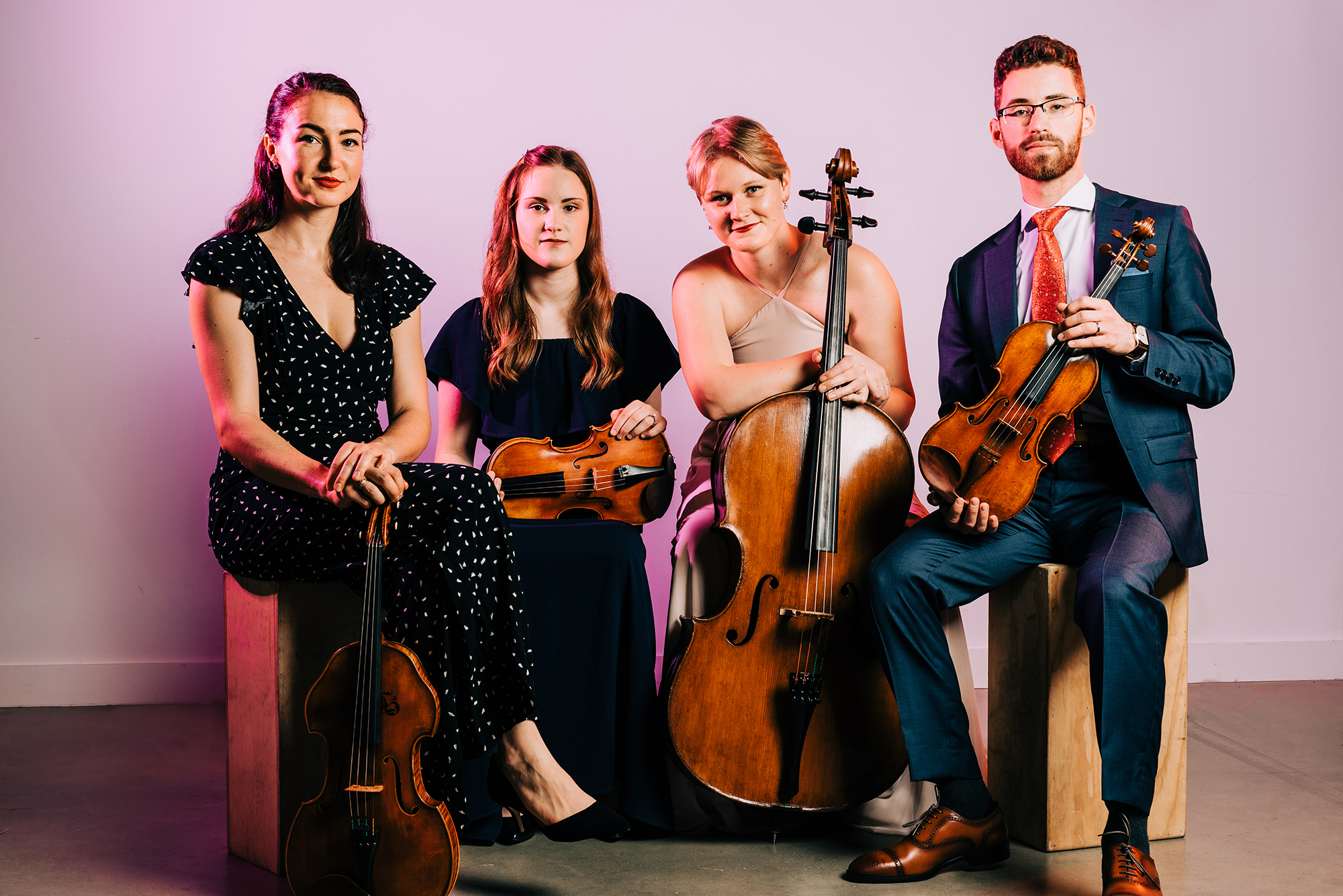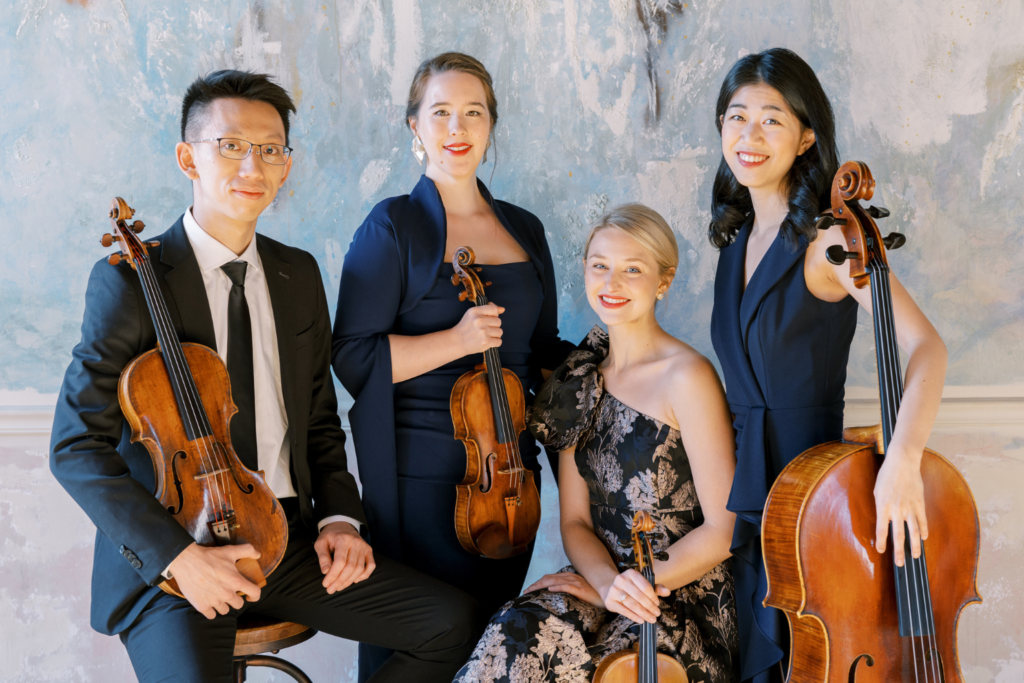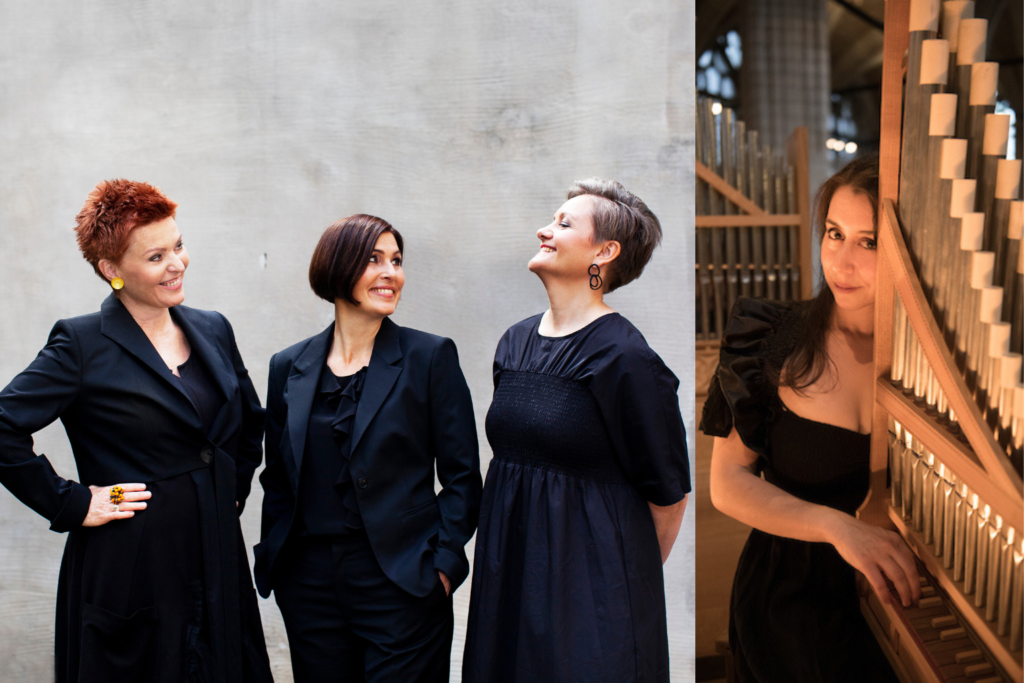
- This event has passed.

Callisto Quartet
2020-21 Ernst Stiefel String Quartet-in-Residence
Thursday July 1, 2021 @ 7:00pm
$30, $40, $46, $55 Garden Listening / $20
Buy TicketsOverview
Thursday July 1, 2021 @ 7:00pm
Praised for their “intensity and bravado” and the “cohesion and intonation one might expect from an ensemble twice their age” (Third Coast Review), the Callisto Quartet was formed in 2016 at the Cleveland Institute of Music, and has since garnered top prizes in the 2018 Fischoff National Chamber Music Competition and the 2019 Banff International String Quartet Competition, as well as several others. For their third performance as Caramoor’s 2020–21 Ernst Stiefel String Quartet-in-Residence, the Callisto Quartet performs works by Haydn, Beethoven, and the world premiere of a Caramoor commission by Saad Haddad.
Artists
Callisto Quartet
Program
Haydn: String Quartet in E-flat Major, Op. 20 No. 1
Saad Haddad: String Quartet No. 2 (World Premiere, commissioned by Caramoor)
Beethoven: String Quartet No. 9 in C Major, Op. 59, No. 3, “Razumovsky”
About the Artists
The Callisto Quartet
Praised for their “intensity and bravado” and the “cohesion and intonation one might expect from an ensemble twice their age” (Third Coast Review), the Callisto Quartet brings together four dedicated and passionate musicians who share a love for chamber music and a true desire for excellence.
Since their formation in 2016 at the Cleveland Institute of Music, the quartet has quickly garnered top prizes in nearly every major international chamber music competition and has been hailed by audiences across North America and Europe. Grand prize winners of the 2018 Fischoff National Chamber Music Competition and Second Prize Winners of the 2019 Banff International String Quartet Competition, the Callisto Quartet has also taken home prizes from the Bordeaux (2019), Melbourne (2018), and Wigmore Hall (2018) competitions.
Currently serving as the Graduate String Quartet in Residence at the Shepherd School of Music at Rice University, they also study with Günter Pichler of the Alban Berg Quartet at the prestigious Escuela Superior de Música Reina Sofía in Madrid, Spain.
The quartet has participated and performed in many renowned chamber music festivals such as the La Jolla Music Society Summerfest, the Great Lakes Chamber Music Festival, the Emilia Romagna Festival, the Norfolk Chamber Music Festival, the McGill International String Quartet Academy, the Juilliard String Quartet Seminar, and the Robert Mann String Quartet Seminar. In 2018, at the invitation of Gerhard Schulz, they attended the Prussia Cove International Musicians Seminar where they also worked with Gidon Kremer and Thomas Adès. As part of their prize from the Wigmore Hall Competition, the Quartet received an invitation to the Jeunesses Musicales International Chamber Music Campus in Weikersheim, Germany where they worked with Heime Müller, Donald Weilerstein, and the Cuarteto Casals.
Highlights of their recent performances include debuts in New York City and Chicago on the Schneider Concert Series and at Ravinia Festival, respectively, as well as at the Heidelberg String Quartet Festival. They were also featured in Carnegie’s Weill Recital Hall in July 2019 as Grand Prize winners of the 4th Manhattan International Music Competition Chamber Music Division. Notable collaborations include appearances with cellist David Geringas at the Cleveland Cello Society’s 20th anniversary concert as well as a collaboration with clarinetist Frank Cohen on the ChamberFest Cleveland Series. Over the past two seasons at the Great Lakes Chamber Music Festival they have collaborated with Paul Watkins, Lawrence Power, Gilles Vonsattel, and John Novacek.
The Callisto Quartet is committed to continually broadening their musical horizons by drawing inspiration from a plethora of mentors and musical approaches. They also believe strongly in passing along their musical insights to younger students and sharing their music in their communities. To this end they have served as faculty and given masterclasses at numerous schools and festivals including the Bravo International Chamber Music Workshop, University of Central Florida, Midwest Young Artists Conservatory, the Greenville Fine Arts Center, and the CIM Preparatory Division. They frequently perform in schools, retirement homes, and other community centers, and are featured as ensemble in residence at the Carolina Music Museum in Greenville, South Carolina.
About the Music
At a Glance
The centerpiece of today’s program is a freshly minted string quartet by Saad Haddad, a young Arab American composer known for his imaginative hybridizing of Western and Middle Eastern musical traditions. Haddad’s String Quartet No. 2 is sandwiched between two masterpieces of the so- called First Viennese School: the first of Haydn’s six Op. 20 Quartets, which bedazzled audiences in the 1770s with their prodigal display of formal and melodic invention, and Beethoven’s Third “Razumovsky” Quartet of 1806.
Known as the “father” of the string quartet, Haydn occupied a pivotal place in music history. In 1732, the year of his birth, the Baroque masters Bach and Vivaldi were still in their primes. By the time he died, 77 years later, his erstwhile pupil Beethoven was ushering in the Romantic era. Haydn’s music reflects the “classical” virtues of equilibrium, clarity, and seriousness of purpose, tempered with a playfulness and often earthy humor that have delighted audiences ever since. Beethoven’s Romanticism posed greater challenges for his contemporaries. The three great quartets that he composed for the Russian count Andreas Razumovsky marked a turning point in his stylistic development. From its somberly mysterious choral introduction to its sparkling fugal finale, the C-Major Quartet holds listeners on the edges of their seats.
The Program
JOSEPH HAYDN
(1732-1809)
String Quartet in E-flat Major, Op. 20, No. 1
About the Composer
One of Haydn’s early biographers, Georg August Griesinger, relates how the composer first tried his hand at writing string quartets in the early 1750s. The future “father” of the string quartet was then teaching music lessons to the children of Baron Carl Joseph Fürnberg in Vienna. According to Griesinger, the baron “had an estate in Weinzierl, several stages from Vienna; from time to time he invited his parish priest, his estate manager, and Albrechtsberger (a brother of the well-known contrapuntist) in order to have a little music. Fürnberg asked Haydn to compose something that could be played by these four friends of the art. Haydn, who was then 18, accepted the proposal, and so originated his first quartet, which, immediately upon its appearance, received such uncommon applause as to encourage him to continue in this genre.
About the Work
The 68 quartets that Haydn went on to compose over the next half-century offer a capsule overview of his artistic development. The earliest quartets, such as the one that beguiled Baron Fürnberg and his guests, were closely related to the string sonatas, sinfonias, and lightweight divertimenti that were popular with European audiences in the Rococo period. In these works the cello was still largely confined to continuo-style harmonic accompaniment, but in Haydn’s hands both the bass line and the quartet’s two inner voices became increasingly independent. By the time he wrote the six Op. 20 Quartets in 1772, the year of his 40th birthday, he was working out a style in which all four instruments were more or less equal partners, thereby laying the foundation for the quartets of Mozart and Beethoven.
A Deeper Listen
Although the E-flat-Major Quartet is less conspicuously innovative than its five companions, there is plenty of evidence that Haydn was determined to loosen the bonds of convention. In the opening Allegro moderato, for instance, the cello quickly sheds its traditional supporting role: listen for its rambunctious dialogue with the first violin in the movement’s minor-key midsection, as the two instruments volley ricocheting 16th-note figures back and forth against a static backdrop of slowly shifting harmonies. The Menuetto’s jovial bounciness contrasts with the suave, hymnlike solemnity of the slow movement (marked “with feeling and sustained”), though both movements are in lilting triple meters. The zesty Finale is notable for its light, transparent texture; the music’s rhythmic buoyancy is accentuated by chains of syncopations that pit the two violins against the lower strings.
SAAD HADDAD
(b. 1992)
String Quartet No. 2
World Premiere, Vol. 22 of Caramoor’s commissioning project: A String Quartet Library for the 21st Century
About the Composer
Born in Georgia to a Lebanese mother and a Jordanian father, Saad Haddad embodies the fertile fusion of cultures that has enriched America’s classical and popular music scenes in recent decades. The 29-year-old composer grew up in the musical melting pot of southern California, in a household where Michael Jackson figuratively rubbed shoulders with Mozart and the traditional musicians of the Arab world. Now based in New York, where he is a Dean’s Fellow at Columbia University and a Young Concert Artists Composer-in-Residence, Haddad has long made a specialty of grafting Arabic compositional and performance idioms onto Western instruments. A case in point is the String Quartet he wrote in 2017 for the Lydian String Quartet, which incorporates elements as diverse as Middle Eastern drumming technique, a fugue from Bach’s Well-Tempered Clavier, and the microtonal scale patterns associated with the traditional Arabic melodic modes.
In the Composer’s Words
In writing my second string quartet, I looked back to a movement of my first string quartet, Fugha, which superimposed the Arab maqamat (modes) over the harmonic motion of a fugue from The Well-Tempered Clavier by J. S. Bach. As I composed, I quite enjoyed this process of ruminating on what Bach might have done if presented with the rich tapestry of possibility from the microtonally inflected Arab modes coupled with his ingenious sense of counterpoint and harmony.
For this work, I went further back in time for inspiration, turning to the often-overlooked Nicola Vicentino, an Italian composer and theorist from the Renaissance period. In his 16th century treatise, “L’antica musica ridotta alla prattica moderna,” he devised a 31- tone system (our “standard” Western system has only 12 tones!) which includes his four-part madrigal, “Musica prisca caput,” where he put his ideas into practice. I used this work as a harmonic template for my own musical exploration. This madrigal is organized into three parts that are distinguished by their pitch content: (1) diatonic (7 possible tones), (2) chromatic (12 possible tones), and (3) microtonal (31 possible tones(!)).
In my work, every chord in “Musica prisca caput” is chronologically represented: almost all of them with their original voice leading, many of which are solely in root position!
They vary from the original by the extension of range (beyond what is possible with human singers), expansion of timbral possibilities (i.e. glissandi, tremolandi, harmonics, etc.), and the implementation of the maqamat to establish a new melodic context for Vicentino’s contrapuntal writing.
By focusing on this distinctly Western point of departure, I hope to provoke a renewed awareness of the richness of Arab traditions and how their facets can coexist within our global cultural landscape.
– Saad Haddad
LUDWIG VAN BEETHOVEN
(1770-1827)
String Quartet No. 9 in C Major, Op. 59, No. 3, “Razumovsky”
About the Composer
Beethoven’s biographer Lewis Lockwood describes the three “Razumovsky” Quartets of 1806 as a “continental divide” in the history of the string quartet. Behind them stood the towering peaks of the Viennese Classical school, epitomized by Haydn and Mozart; ahead lay the as-yet-uncharted territory of Schubert, Mendelssohn, Schumann, and Brahms. The Op. 59 set marked a watershed in Beethoven’s own artistic development as well. Like the “Eroica” Symphony, the “Appassionata” Piano Sonata, and the opera Fidelio, the “Razumovskys” exemplify the “heroic” and boldly unconventional style that Beethoven forged in his so-called middle period, under the incubus of his steadily worsening loss of hearing. The Mozartean Classicism of his six Op. 18 Quartets, composed between 1798 and 1800, already belonged to a different world, while the introspective, convoluted language of his late quartets lay just around the corner.
About the Work
The Op. 59 Quartets were commissioned by Count Andreas Razumovsky, Russia’s ambassador to the court of Vienna. An enthusiastic amateur violinist, the count was an ardent champion of both Beethoven and Haydn. Beethoven set to work on May 26, 1806, and completed the three quartets by the end of the year. Predictably, contemporary reactions to the “Razumovskys” ranged from bemusement to outright hostility. When the violinist Ignaz Schuppanzigh’s celebrated ensemble read through the first piece in the set, the players reportedly “laughed and were convinced that Beethoven was playing a joke and that it was not the quartet which had been promised.” The great Russian cellist Bernhard Romberg, upon discovering that he had nothing to play at the beginning of a certain movement but repeated B-flats, flung the music on the floor and trampled on it. Beethoven was not unduly perturbed by such displays of incomprehension. The Op. 59 Quartets, he coolly informed one of his critics, “are not for you, but for a later age.”
A Deeper Listen
The C-Major Quartet’s darkly mysterious chordal introduction advertises the seriousness of Beethoven’s intentions, but the tone of the ensuing Allegro vivace, with its skipping dotted theme, is incongruously lighthearted. Not until the slow movement does darkness descend again, in the dirgelike tolling of the cello’s subterranean pizzicato (plucked) notes. Although the upper strings’ mournful plaint is twice interrupted by a dancing countermelody, the movement ends in somber A minor. The genial Menuetto and its strutting Trio midsection both make ample use of the flowing 16th-note roulades we’ve encountered earlier in the Quartet. A brief coda serves as a bridge to the Allegro molto: the viola bursts out of the gate, leading the foursome on a merry fugal chase that’s charged with electric energy, and Beethoven’s inexhaustible ingenuity keeps us on the edge of our seats all the way to the surprise ending. On a sketch for the last movement, the composer wrote defiantly, “Let your deafness be no more a secret — even in art.”
— Harry Haskell
All artists and dates are subject to change and cancellation without notice as we work closely with local health experts and officials. Please note that all performances at Caramoor are in compliance with current New York State Regulations. Read our latest Health & Safety updates.


